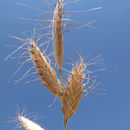Distribution in Egypt
provided by Bibliotheca Alexandrina LifeDesk
- author
- BA Cultnat
- provider
- Bibliotheca Alexandrina
Global Distribution
provided by Bibliotheca Alexandrina LifeDesk
East Mediterranean region, Sinai, eastwards to Tibet and the Himalaya.
- author
- BA Cultnat
- provider
- Bibliotheca Alexandrina
Habitat
provided by Bibliotheca Alexandrina LifeDesk
- author
- BA Cultnat
- provider
- Bibliotheca Alexandrina
Life Expectancy
provided by Bibliotheca Alexandrina LifeDesk
- author
- BA Cultnat
- provider
- Bibliotheca Alexandrina
Comments
provided by eFloras
Bromus danthoniae has been placed in B. sect. Triniusia (Steudel) Nevski. However, the available molecular data indicate that the species is nested within B. sect. Bromus.
- license
- cc-by-nc-sa-3.0
- copyright
- Missouri Botanical Garden, 4344 Shaw Boulevard, St. Louis, MO, 63110 USA
Comments
provided by eFloras
This is a very handsome grass often with purple awns and pale green lemmas with silvery margins.
- license
- cc-by-nc-sa-3.0
- copyright
- Missouri Botanical Garden, 4344 Shaw Boulevard, St. Louis, MO, 63110 USA
Description
provided by eFloras
Annual. Culms erect or geniculately ascending, 30–50 cm tall, pubescent below inflorescence. Leaf sheaths pubescent; leaf blades 10–15 cm × 2–4 mm, both surfaces densely pubescent or later glabrescent. Panicle contracted or racemelike, dense, ovate in outline, 5–10 × 1–5 cm; branches and pedicels shorter than spikelets, ascending, scabrid. Spikelets oblong-lanceolate, 20–40 × 6–12 mm, florets 8–16, overlapping; rachilla internodes not visible; glumes broad, lower glume 5–8.5 mm, 3–5-veined, upper glume 7–9 mm, 7–9-veined; lemmas broadly elliptic, 9–12 mm, glabrous, pubescent or villous, 9–11-veined, veins scabrid, margins broadly membranous, broader and obtusely angled in upper half, apex lacerate, lowest lemmas shortly 1-awned, upper lemmas 3-awned from 2–4 mm below apex; central awn 15–25 mm, base flattened, twisted, recurved, lateral awns 4–10 mm, straight or recurved; palea shorter than lemma, keels ciliate. Anthers 1–1.8 mm. Fl. May–Aug.
- license
- cc-by-nc-sa-3.0
- copyright
- Missouri Botanical Garden, 4344 Shaw Boulevard, St. Louis, MO, 63110 USA
Description
provided by eFloras
Annual; culms erect or geniculately ascending, up to 50 cm high. Leaf-blades up to 15 cm long, 2-4 mm wide; sheaths glabrous or pubescent. Panicle ovate, 4-12 cm long, the branches short and ascending. Spikelets elliptic or oblong-elliptic; 6-8-flowered, 15-35(-45) mm long excluding the awns, the lemmas overlapping, concealing the internodes; lower glume lanceolate, 5-8.5 mm long, 3-5-nerved; upper glume narrowly ovate, 6.5-9.5 mm long, 7-9(-11)-nerved; lemmas oblanceolate in side view, the lower 9-12 mm long, herbaceous with broad silvery-hyaline margins widened above the middle into an obtuse angle, sometimes the margin with a blunt tooth, 9-11-nerved, glabrous or pubescent on the body, the nerves glabrous to scaberulous or ciliolate, minutely several-toothed at the tip, the lowest lemmas 1-awned, sometimes with the awn greatly reduced, the upper lemmas 3-awned with the awns arising from the back below the tip, usually purple-tinged. the central 15-25 mm long, strongly reflexed, the lateral 4-10 mm long, erect or also reflexed; palea shorter than the lemma, ciliolate on the keels; anthers 1-1.8 mm long.
- license
- cc-by-nc-sa-3.0
- copyright
- Missouri Botanical Garden, 4344 Shaw Boulevard, St. Louis, MO, 63110 USA
Distribution
provided by eFloras
W Xizang [Afghanistan, NW India, Kazakhstan, Kyrgyzstan, Pakistan, Russia, Tajikistan, Turkmenistan, Uzbekistan; SW Asia, Mediterranean (Cyprus)].
- license
- cc-by-nc-sa-3.0
- copyright
- Missouri Botanical Garden, 4344 Shaw Boulevard, St. Louis, MO, 63110 USA
Distribution
provided by eFloras
Distribution: Pakistan (Baluchistan & Kashmir); Cyprus eastwards through the Middle East to southern Russia and Tibet.
- license
- cc-by-nc-sa-3.0
- copyright
- Missouri Botanical Garden, 4344 Shaw Boulevard, St. Louis, MO, 63110 USA
Flower/Fruit
provided by eFloras
Fl. & Fr. Per.: April-July.
- license
- cc-by-nc-sa-3.0
- copyright
- Missouri Botanical Garden, 4344 Shaw Boulevard, St. Louis, MO, 63110 USA
Habitat
provided by eFloras
Wastelands, dry grassy places on gravel slopes; 1500–3000 m.
- license
- cc-by-nc-sa-3.0
- copyright
- Missouri Botanical Garden, 4344 Shaw Boulevard, St. Louis, MO, 63110 USA
Synonym
provided by eFloras
Boissiera danthoniae (Trinius) A. Braun; Bromus lanceo-latus Roth var. danthoniae (Trinius) Dinsmore; B. macro-stachys Desfontaines var. danthoniae (Trinius) Ascherson & Graebner; Triniusa danthoniae (Trinius) Steudel.
- license
- cc-by-nc-sa-3.0
- copyright
- Missouri Botanical Garden, 4344 Shaw Boulevard, St. Louis, MO, 63110 USA
Bromus danthoniae
provided by wikipedia EN
Bromus danthoniae, the oat brome or three-awned brome, is a species of flowering plant in the family Poaceae, native to Turkey, Cyprus, the Caucasus region, the Middle East, Central Asia, Afghanistan, Pakistan, the western Himalayas, and Tibet.[2] It is rarely discovered growing in other locations, but apparently not in sustained populations.[1] It grows in a wide variety of habitats, and shows morphological variation due to the differing conditions in those habitats.[3]
References
-
^ a b "Bromus danthoniae Trin". Plants of the World Online. Board of Trustees of the Royal Botanic Gardens, Kew. Retrieved 25 September 2021.
-
^ "Bromus danthoniae Trin". intermountainbiota.org. Intermountain Regional Herbarium Network. January 2021. Retrieved 25 September 2021.
-
^ Naderi, R.; Rahiminejad, M. R.; Assadi, M.; Vitek, E. (2016). "A new taxonomic concept for Bromus danthoniae including comments on Bromus sectt. Bromus and Triniusia (Poaceae)". Annalen des Naturhistorischen Museums in Wien. Serie B für Botanik und Zoologie. 118: 167–180. JSTOR 43922692.

- license
- cc-by-sa-3.0
- copyright
- Wikipedia authors and editors
Bromus danthoniae: Brief Summary
provided by wikipedia EN
Bromus danthoniae, the oat brome or three-awned brome, is a species of flowering plant in the family Poaceae, native to Turkey, Cyprus, the Caucasus region, the Middle East, Central Asia, Afghanistan, Pakistan, the western Himalayas, and Tibet. It is rarely discovered growing in other locations, but apparently not in sustained populations. It grows in a wide variety of habitats, and shows morphological variation due to the differing conditions in those habitats.
- license
- cc-by-sa-3.0
- copyright
- Wikipedia authors and editors

